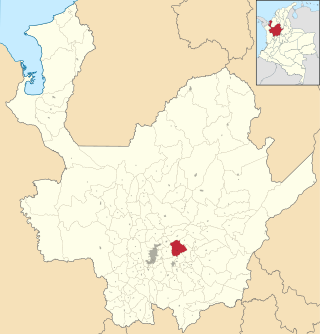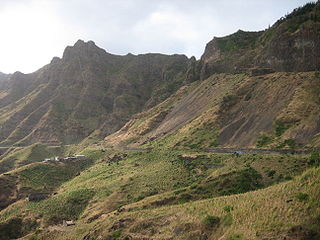
Yucca is a genus of perennial shrubs and trees in the family Asparagaceae, subfamily Agavoideae. Its 40–50 species are notable for their rosettes of evergreen, tough, sword-shaped leaves and large terminal panicles of white or whitish flowers. They are native to the hot and dry (arid) parts of the Americas and the Caribbean.
Maguey may refer to various American plants:

The Ruth Bancroft Garden is a 2.5-acre (1.0 ha) public dry garden established by Ruth Bancroft. It contains more than 2,000 cactus, succulents, trees, and shrubs native to California, Mexico, Chile, South Africa, and Australia. It is located at 1552 Bancroft Road in Walnut Creek, California, USA.

Furcraea foetida is a species of flowering plant native to the Caribbean and northern South America. It is widely cultivated and reportedly naturalized in many places

The Yungas is a bioregion of a narrow band of forest along the eastern slope of the Andes Mountains from Peru and Bolivia, and extends into Northwest Argentina at the slope of the Andes pre-cordillera. It is a transitional zone between the Andean highlands and the eastern forests. Like the surrounding areas, the Yungas belong to the Neotropical realm; the climate is rainy, humid, and warm.

San Vicente Ferrer is a town and municipality in Antioquia Department, Colombia. The town of San Vicente is part of the sub-region of Eastern Antioquia.

Beschorneria is a genus of succulent plants belonging to the family Asparagaceae, subfamily Agavoideae, native to semi-arid areas of Mexico and Central America. They are generally large evergreen perennials forming clumps of grey-green leaves, with tall flower-spikes to 1.5 metres (4.9 ft). Marginally hardy, they may require winter protection in areas subject to frost.
- Beschorneria albifloraMatuda - Oaxaca, Chiapas, Guatemala, Honduras
- Beschorneria calcicolaA.García-Mendoza - Puebla, Oaxaca, Veracruz
- Beschorneria dubiaCarrière - Tamaulipas
- Beschorneria rigidaRose - Guanajuato, San Luis Potosí, Puebla
- Beschorneria septentrionalisA.García Mendoza - Tamaulipas, Nuevo León
- Beschorneria tubiflora(Kunth & C.D.Bouché) Kunth - San Luis Potosí, Hidalgo
- Beschorneria wrightiiHook.f - México State
- Beschorneria yuccoidesK.Koch - Hidalgo, Puebla, Veracruz

Furcraea is a genus of succulent plants belonging to the family Asparagaceae, native to tropical regions of Mexico, the Caribbean, Central America and northern South America. Some species are also naturalized in parts of Africa, the United States (Florida), Portugal, Thailand, India, and Australia, as well as on various oceanic islands. They are xerophytic monocots.

A bulbil is a small, young plant that is reproduced vegetatively from axillary buds on the parent plant's stem or in place of a flower on an inflorescence. These young plants are clones of the parent plant that produced them—they have identical genetic material. The formation of bulbils is a form of asexual reproduction, as they can eventually go on to form new stand-alone plants.

Serra Malagueta is a mountain range located in the northern part of the island of Santiago, Cape Verde. At 1064 m elevation, it is highest point of northern Santiago. The mountain range is protected as the Serra Malagueta Natural Park, that was established on February 24, 2005 and covers 774 hectares. The natural park is situated in the municipalities Tarrafal, São Miguel and Santa Catarina. The summit is in São Miguel, south of the Ribeira Principal valley. The Serra Malagueta formation is of volcanic origin, and was formed between 2.9 and 2.4 million years ago.

Fique is a natural fibre that grows in the leaves of plants in the genus Furcraea. Common names include fique, cabuya, pita, penca, penco, maguey, cabui, chuchao and coquiza.

Antón is a district (distrito) of Coclé Province in Panama. The population according to the 2000 census was 44,039. The district covers a total area of 749 km². The capital lies at the city of Antón.

Parita District is a district (distrito) of Herrera Province in Panama. The population according to the 2000 census was 8,827. The district covers a total area of 364 km². The capital lies at the city of Parita.

Chame is a district (distrito) of Panamá Oeste Province in Panama. The population according to the 2000 census was 19,625; the latest official estimate is 31,373. The district covers a total area of 377 km2. The capital lies at the city of Chame.

Furcraea andina is a species of plant in the family Asparagaceae that is native to South America. The fibres in its leaves, known as fique, are used in making ropes.

Cabuya is a small fishing village on the Nicoya Peninsula of Costa Rica.
Furcraea niquivilensis is a plant species native to Chiapas, Mexico.
Macanavirus is a genus of viruses, in the family Tombusviridae. Plants serve as natural hosts. There is only one species in this genus: Furcraea necrotic streak virus. Diseases associated with this genus include: macana disease.

Furcraea tuberosa is a species of flowering plant in the family Asparagaceae, native to the Caribbean. It is naturalized in part of South Africa. Plants have a limited use as a source of fibre.















